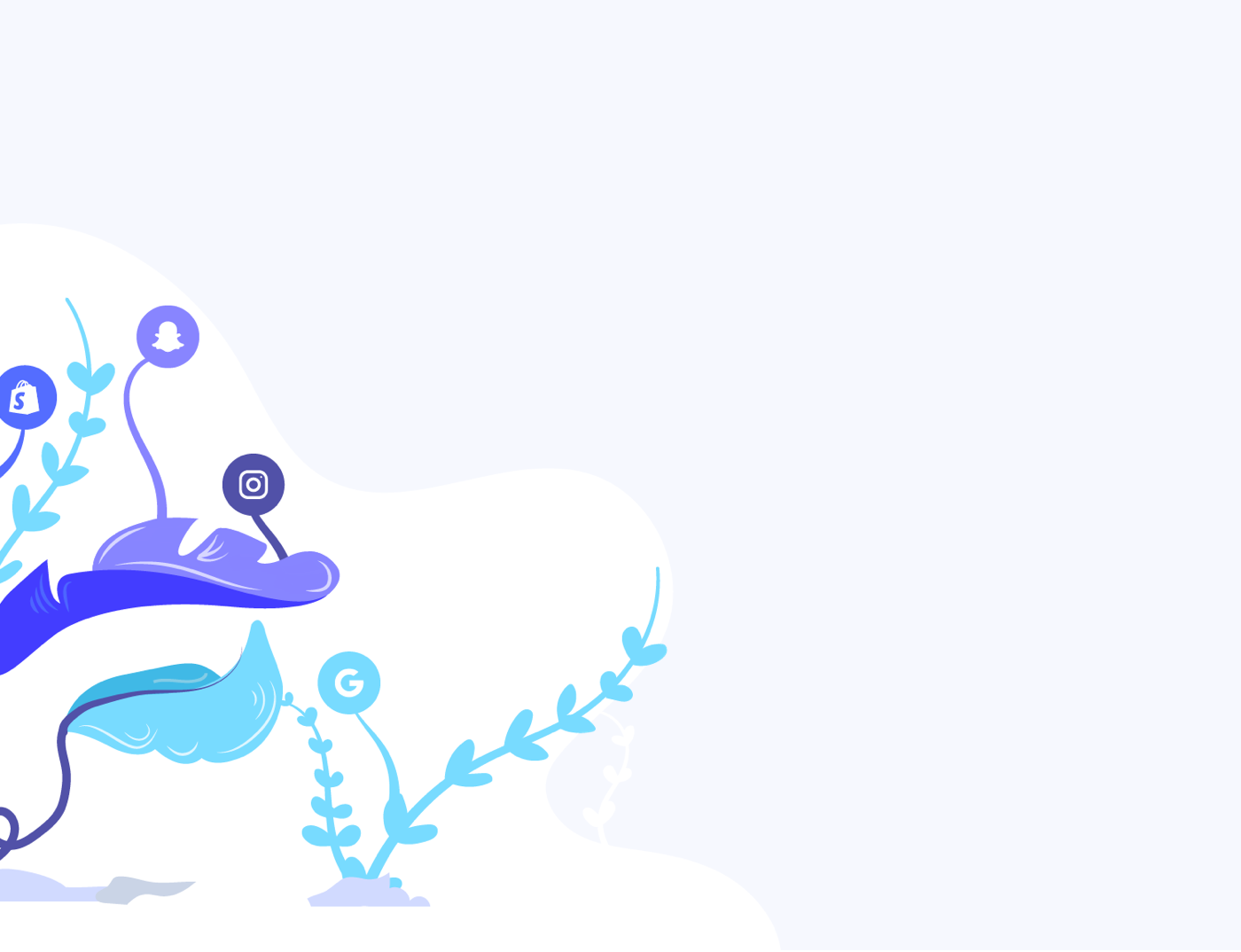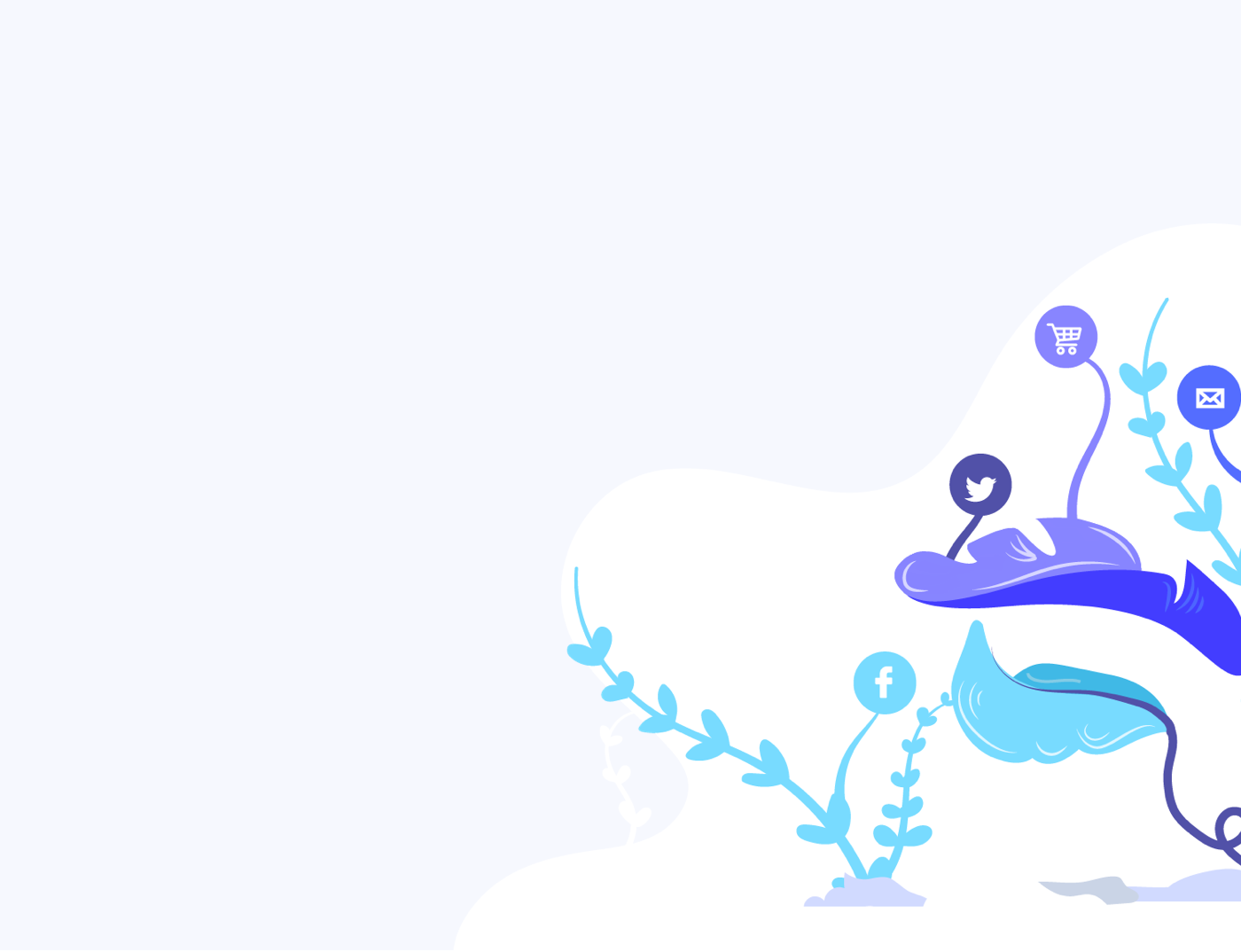The numbers are in. Ecommerce represents a huge opportunity at the moment, with Statista predicting a 246.15% increase in global ecommerce sales between 2014 and 2021, from $1.3 trillion to $4.5 trillion in total.
But whether you’re a new seller trying to capitalize on this opportunity or an emerging brand attempting to claim market share, challenge – as well as opportunity – abounds. Setting up a store, performing product research and firing off your first ad campaign won’t be enough to achieve consistent sales.
To be profitable in the long-term, you need an optimized conversion funnel.
What are Conversion Funnels (And Why Do You Need One)?
Funnels aren’t as complicated as they sound. A funnel is merely a representation of the journey that potential customers travel as they move toward becoming paying customers.
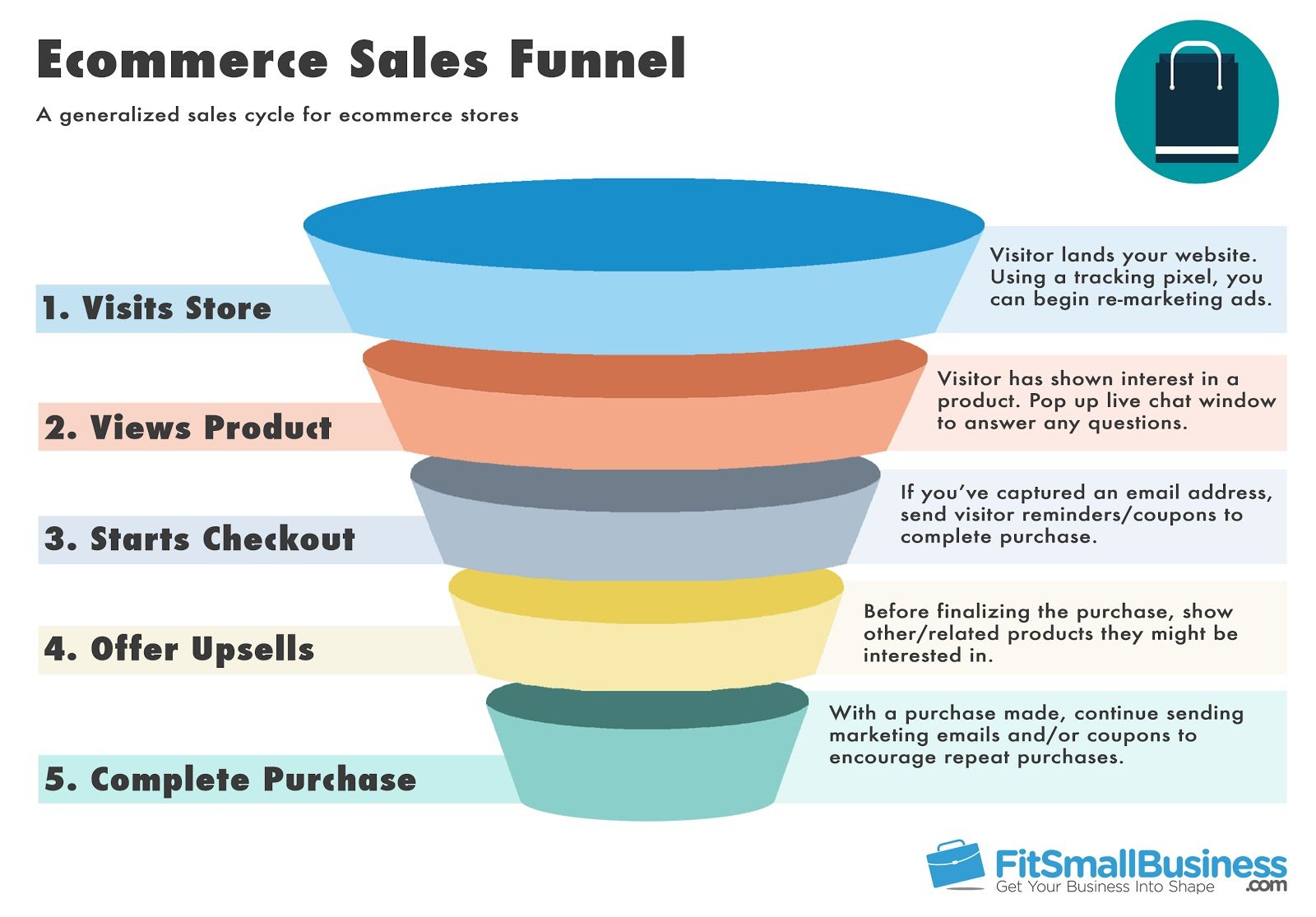 A typical ecommerce sales funnel, courtesy of Fit Small Business
A typical ecommerce sales funnel, courtesy of Fit Small Business
Maximizing your ecommerce store’s profits means optimizing every stage of this process, both encouraging quick passage from one stage to the next and plugging the funnel exit holes that are costing you sales.
This process falls under the broader umbrella of conversion rate optimization, or CRO.
What You Need to Perform Ecommerce Funnel Conversion Rate Optimization (CRO)
You only need a few things to perform ecommerce funnel CRO:
- An understanding of your ecommerce store’s funnel
- An analytics tool to measure the performance of your funnel
- A hypothesis you believe will improve your site’s performance in some way (and a way to test it)
Mapping Your Ecommerce Funnel
Funnels are generally thought to have three levels:
- Top of funnel
- Middle of funnel
- Bottom of funnel
Take another look at the FitSmallBusiness graphic I shared earlier:

- The top of the funnel is where new prospects first become aware of your brand. Engagements are generally light in nature – visiting your pages or viewing your products, for example.
- In the middle of the funnel, your prospects engagement with your company intensifies. Prospects become leads as they begin to explore your offerings at a deeper level, with a greater likelihood of purchasing.
- Finally, the bottom of the funnel represents the ultimate engagement – when leads become customers by actually buying from your brand.
Not every customer that visits your website will buy from you, which is why the funnel is cone-shaped. Visitors leak out of your funnel at every stage. Optimizing your ecommerce funnel comes down to removing friction from one stage to the next, as well as keeping more people inside until they make a purchase.
That said, you can’t make either of these changes until you’re clear on how each funnel stage maps to your unique store. The easiest way to do that is to work backwards from your ultimate goal: ecommerce sales.
Ask yourself the following questions:
- What do my leads do before making a purchase?
- What elements on my site contribute to (or possibly hinder) sales?
- What techniques do I use to deepen engagement with my store (to turn prospects into leads)?
- How do I help prospects find the right products?
- How do I encourage new visitors to spend more time on my website?
- How do new visitors first find my site?
Working backwards will give you some insight into your funnel, as will the discussion of stage optimization techniques later in this article. But to really understand what your funnel is and how it’s working, you’ll need an analytics program.
Using Analytics Tools for Funnel Measurement
We’re going to get into some technical advice for a minute, but stick with me. Even if you aren’t a data and analytics wizard, there are options that’ll help you better understand your funnel’s performance.
I like to break these tools down into three options:
- Simple Goals tracking with Google Analytics
- Advanced Goal Flow reporting with Google Analytics
- Specialized funnel performance software
Simple Goals tracking with Google Analytics
Totally new to funnel optimization? Start with the free Google Analytics Goals report.
- Sign into Google Analytics and select the URL you want to set up goals for.
- Click “Admin” and then underneath “View”, select “Goals”.
- Next, click the “New Goal” button, give your goal a sensible name and select the type of goal you want (such as the duration a user spends on a page or the amount of pages per session).
Google offers you several different Goal template options, though most new ecommerce sellers will want to choose the “Make a payment” option at first.
 After you’ve selected “Make a payment,” you’ll be prompted to choose from four different goal completion types:
After you’ve selected “Make a payment,” you’ll be prompted to choose from four different goal completion types:
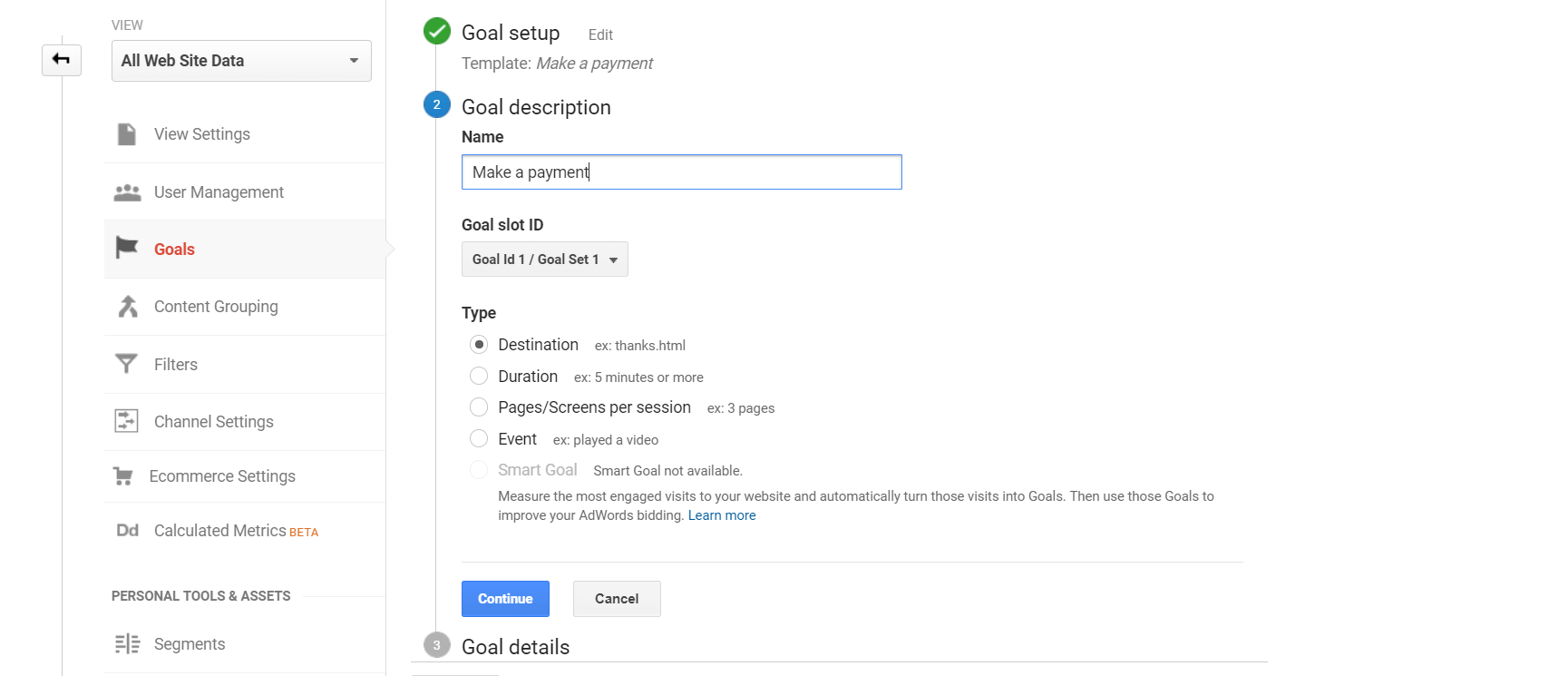 Destination goals are the easiest option here. Plug your defined thank you page into the Goal setup, and turn on the “Revenue” option if you’re selling a single product, at a single price. Putting the purchase price in will add revenue measuring to your analytics.
Destination goals are the easiest option here. Plug your defined thank you page into the Goal setup, and turn on the “Revenue” option if you’re selling a single product, at a single price. Putting the purchase price in will add revenue measuring to your analytics.
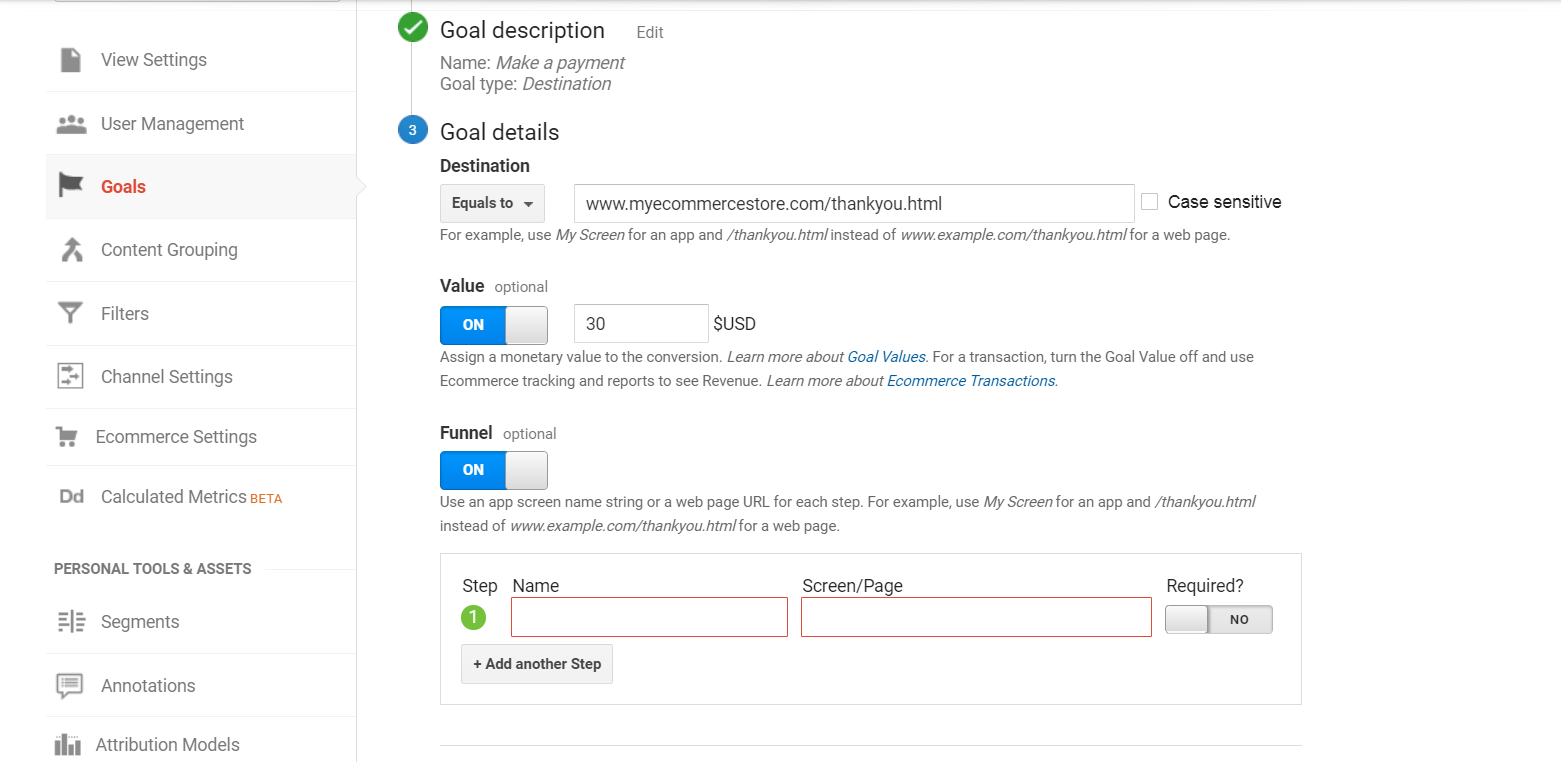 If visitors generally follow a specific path to reach your checkout and thank you page, turn on Funnel tracking and add the relevant steps to track funnel entrances and exits. With this feature enabled, you’ll be able to view GA’s full funnel stage report:
If visitors generally follow a specific path to reach your checkout and thank you page, turn on Funnel tracking and add the relevant steps to track funnel entrances and exits. With this feature enabled, you’ll be able to view GA’s full funnel stage report:
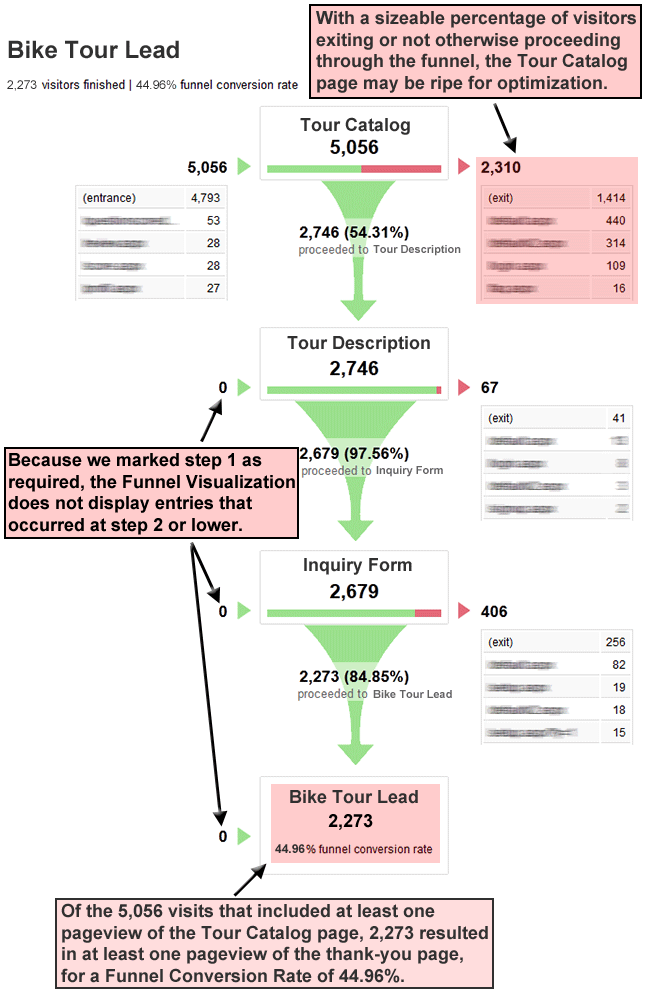 Image Source: Kissmetrics
Image Source: Kissmetrics
As an extra tip, don’t forget to install Google Analytics’s ecommerce tracking feature while you’re in there. It’s not a funnel optimization tool, per se, but the reports generated can still provide valuable insight about your site’s overall health.
Find it under “Conversions > Ecommerce”:
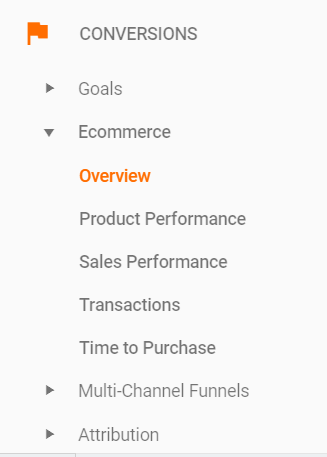 Advanced Goal Flow reporting with Google Analytics
Advanced Goal Flow reporting with Google Analytics
Knowing how visitors are moving through your funnel is important. Knowing visitors are becoming prospects, then leads, and then customers is even better.
Google Analytics’s Goal Flow report provides that level of granularity by allowing you to segment your funnel mapping by segment:
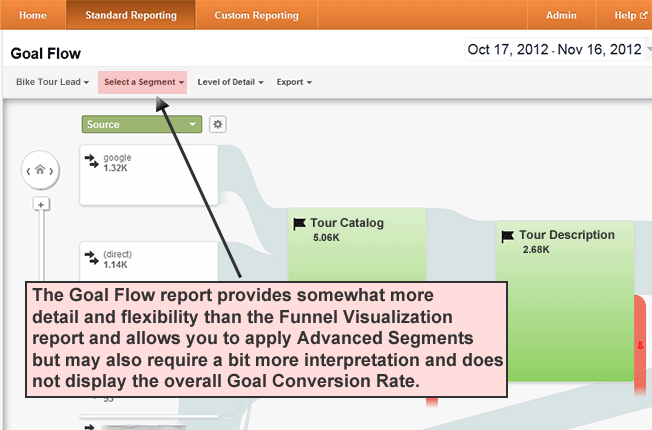 Image Source: Kissmetrics
Image Source: Kissmetrics
For more on setting up this report, visit Google’s Support page here. Once you’re up-and-running, test different segments to answer the following types of questions:
- Do visitors from one traffic source perform better than another?
- Which stages in your funnel have the most leaks?
- When prospects leak out of one stage, are they returning to another or leaving your site?
- Did some of your customers skip your identified funnel entirely? If so, what does that tell you about your understanding of your funnel?
- Do you see any loop-backs? A loop-back to your search page from another node may suggest users aren’t finding what they need there.
The Goal Flow report takes some practice to get used to, but it can provide plenty of valuable insight to your ecommerce CRO efforts.
Specialized funnel performance software
Finally, if your needs exceed Google Analytics’s capabilities (or if you have the budget to spend on more intuitive funnel analysis offerings), you may find specialized funnel performance software a better fit for your needs.
The following are just a few options to explore:
Your ecommerce platform provider may also offer some of this specialized reporting, as in the case of Volusion.
Developing Ecommerce CRO Hypotheses
As you’ve mapped your ecommerce funnel and gathered data on its performance, you’ve probably already begun to notice its weak points.
- Maybe you aren’t making many sales because you aren’t getting much web traffic in the first place.
- Maybe you’re getting good traffic, but few of these prospects are making it to your checkout page.
- Or maybe you see a greater drop-off within the checkout process itself, suggesting that leads give up their purchases at the last minute for some reason.
Whatever the case may be, your next step is to design an experiment you expect would improve your results. The three hypotheses below could be used to attempt fixing the problems described above:
- Adding a new top of funnel traffic source (say, paid Facebook ads) would increase funnel entrants, and therefore – hopefully – final sales.
- Building trust elements like safety seals or social testimonials into your product pages might increase middle of funnel engagement, leading to more checkout attempts.
- Removing required account registration might ensure more of leads complete purchases at the bottom of your funnel.
If you aren’t sure which technique to test, check out the second half of this guide, which is a listing of ecommerce CRO tactics separated by funnel stage. Choose between them based on your skills, available resources, and the funnel stages where you have the biggest problems.
As a side note, there’s a lot of debate among ecommerce experts over which funnel stage you should optimize first. Some believe you should start at the top of your funnel, as getting more prospects into your sales process improves your ability to carry out statistically-significant testing. Others say, optimize the conversion process first so that whatever visitors you get in the future will be as likely as possible to buy.
My suggestion? Make the changes you think will be most likely to give you the greatest results, as quickly as possible.
Wherever you decide to start, choose one hypothesis to test at a time, and put a tool in place that’ll enable you to properly test different variants. Google Analytics’s Content Experiments is a great place to start, as are any of the other ecommerce testing tools available.
Funnel Optimization Strategies
Top of Funnel Optimization
Facebook Advertising
Test different headlines, body copy variations, creatives and CTAs, paying attention to your overall:
- Cost per acquisition (CPA)
- Clickthrough rate (CTR)
- Cost per click (CPC)
After you have the basics down and you’re generating some data, try testing the following targeting options:
- Interests
- Age
- Device
- Image
- Custom and Lookalike Audiences
Organic Social Media
While paid advertising is all the rage at the moment, there’s no reason why you can’t supplement this with organic traffic from social media.
As an example, when other businesses in the industry were focused on paid traffic, hair extensions brand, Luxy Hair, drove astronomic profits by creating a helpful YouTube channel delivering hairstyling tutorials.
 Because the channel was aimed at delivering value rather than self-promotion, this helped to build long-term trust and – therefore – long-term profits.
Because the channel was aimed at delivering value rather than self-promotion, this helped to build long-term trust and – therefore – long-term profits.
Influencer Marketing
Influencer marketing is incredibly powerful for ecommerce stores. Particularly on visual platforms such as YouTube and Instagram, you can generate a huge ROI by paying influencers to take pictures with your product with a link to your brand account or website.
 With resources such as Ifluenz, finding influencers for paid promotions in any niche is easy.
With resources such as Ifluenz, finding influencers for paid promotions in any niche is easy.
While not an ecommerce example, legendary entrepreneur and content marketer, Neil Patel, achieved huge social media engagement and improved Google searches for his name by 71% by paying Instagram models to post on his behalf.
SEO
SEO often gets left out of the CRO conversation. It’s not sexy, and it’s not going to send huge traffic numbers to your site the same way paid ads will.
That doesn’t mean you can afford to ignore it. Organic search traffic is the lifeblood of many online stores. Follow the best practices below to shore up any leaks due to a lackluster search presence that you may not even know you have.
- Ahrefs: “A Simple (But Complete) Guide To Ecommerce SEO”
- Backlinko: “Ecommerce SEO: The Definitive Guide”
- Kissmetrics: “The Ultimate Guide to SEO for E-commerce Websites”
PPC
The natural complement to SEO for top of funnel ecommerce brand awareness is PPC, or pay-per-click advertising. If you want to test it out (and do it well), keep the following tips in mind:
- Don’t ignore your quality score. Follow established best practices to keep your ad rates as low as possible.
- Test different audiences and placements. You might have guesses about which combinations will perform best, but you need actual data to make a final decision.
- Always be split testing. Use the tools built into your PPC engine (hint: there’s more than just Google Adwords) to optimize not just your ecommerce funnel, but the individual ads contributing to it as well.
As with paid social, watch your budget carefully. It’s easy to overspend on paid advertising and have little to show for it. Monitor the ROI of any paid ad campaign you run and make changes as needed.
Middle of Funnel Optimization
Retargeting
Once a user has left your website, you can only communicate with them if they’ve signed up to your mailing list or made a purchase – unless you use retargeting.
Use retargeting to engage users who have visited your website, but for whatever reason, haven’t converted. In this world of eternal distractions, a visitor not converting doesn’t necessarily mean they weren’t interested in your product. They may have just not been ready at the time.
Research suggests that retargeting can boost ad response by 400%.
Kimberly Clark, a retailer of personal and healthcare products, enjoys 50-60% higher conversion rates for customers who’ve been retargeted.
Facebook (which controls ads on both Facebook and Instagram) offers arguably the most powerful retargeting platform available (though Google Adwords is worth a look as well). When a user sees an ad from a familiar company while scrolling through their Facebook newsfeed, this can feel less disruptive than other ad platforms.
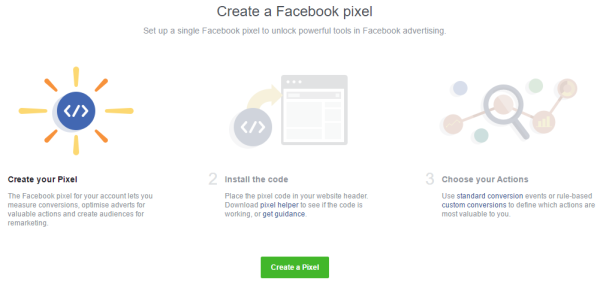 After setting up your Facebook Pixel, create a Custom Audience for people who have visited your product pages, but who haven’t visited your thank you page (indicating they’re not a paying customer).
After setting up your Facebook Pixel, create a Custom Audience for people who have visited your product pages, but who haven’t visited your thank you page (indicating they’re not a paying customer).
Next, fire off an ad campaign at these individuals reminding them of the product they’re missing. Adding some urgency in the ad copy, such as a limited discount, can be useful for encouraging conversions.
 This ad by Target effectively utilizes scarcity.
This ad by Target effectively utilizes scarcity.
Email Marketing
As paid advertising is becoming more competitive, many ecommerce store owners are choosing to deploy the kinds of longer sales funnels more commonly seen in B2B businesses.
Offering discount codes, free giveaways and lead magnets, for example, is a common way to get leads on your mailing list, where you can nurture them further over time.
When you visit the online vegan grocery store, Vegan Kind, for instance, you’re immediately greeted with a popup that incentivizes email opt-ins. Not only is there a discount voucher and free ebook, there’s also the chance to win a 12 month subscription.
 Even if you have a highly qualified audience, Facebook advertising costs money. Email, on the other hand, costs nearly nothing to send.
Even if you have a highly qualified audience, Facebook advertising costs money. Email, on the other hand, costs nearly nothing to send.
For more information about building a powerful email funnel, check out my previous article here.
Trust Elements
If you’re sending cold traffic to your website from PPC advertising (let alone any other promotional strategy), it’s crucial that your website has the look and feel of an authentic, legitimate business.
The following factors help:
- The quality of your content
- Your “About Us” page
- Prominent trust seals from sites like Norton or McAfee
Zamberg, an online retailer of grooming products, improved sales by 11% after featuring an SSL certificate on its website.
Customer Reviews
Customer reviews are an excellent form of trust-building social proof. Don’t expect your product page to convert well without them.
A study by BrightLocal found that 72% of buyers will take action only after reading a positive review. Text reviews are good, but they’re also easy to fake. For this reason, video reviews are treated with higher credibility.
 Pro-aging cosmetics brand, Boom by Cindy Joseph, for example, features plenty of customer video reviews on every product page.
Pro-aging cosmetics brand, Boom by Cindy Joseph, for example, features plenty of customer video reviews on every product page.
Live Chat
In addition to displaying trust seals or featuring a comprehensive FAQ section on your site, live chat is another option for making potential customers feel secure in their purchase.
In a study by Boldchat, 72% of British and American customers said they would be more likely to complete a purchase after talking on live chat.
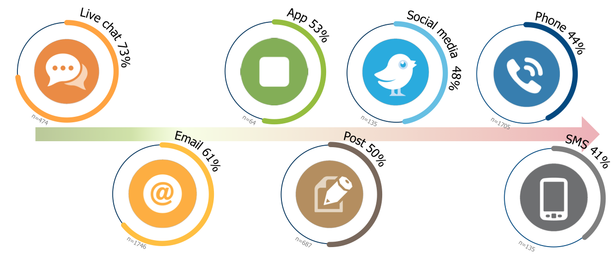 Adding live chat to your site doesn’t have to be complicated. There are a number of powerful plugins that can be installed on your store in order start a dialogue with potential customers and supercharge conversions.
Adding live chat to your site doesn’t have to be complicated. There are a number of powerful plugins that can be installed on your store in order start a dialogue with potential customers and supercharge conversions.
Bottom of Funnel Optimization
Be Clear About Shipping Costs
According to Statista research, 56% of online consumers state that being presented with unexpected costs is the reason they don’t complete their purchases.
This is corroborated in a study by Deloitte, finding that 69% of consumers are more likely to buy from stores that offer free shipping.
Be clear about your shipping costs, and offer free shipping if you can to prevent leads from getting hung-up at this stage.
Offer Numerous Payment Options
Limiting your store’s payment options is one of the fastest ways to drive down your conversion rate. Offering Visa, American Express, Mastercard and Paypal should cover the vast majority of customers.
Exit Intent Popups
With applications like Better Coupon Box, you can craft your own exit intent popups in order to compel customers who are about to leave your site to stay.

Remove Account Registration
In order to maximize conversions, your checkout process should be as fast and simple as humanly possible. Forcing users to create an account in order to make a purchase is an unnecessary waste of time that could ultimately cost you the conversion.
A study by User Interface Engineering found that by removing compulsory account registration at the checkout page, customer purchases increased by 45%.
Retargeting
As described above, retargeting is great for pushing potential customers from the middle of your funnel to the bottom of your funnel. It’s even more effective for driving potential customers who show high buying intent through the end of your funnel.
When firing off a Facebook retargeting campaign for potential customers with high buying intent, target events such as:
- Adding a product to their cart
- Initiating the checkout process
- Filling in payment details
As an additional measure, you may want to combine one of the above events with visiting your “About Us” page, as this indicates leads have taken the time to research your business.
Remember to exclude users who have visited your thank you page, so you don’t accidently target paying customers.
If a user shows high buying intent, the probability of them converting is exponentially higher the day after the event than it is a week later. Consider only retargeting users who have visited your website within the last week in order to maximize the return from your ad spend.
Abandoned Cart Email Sequences
If a user inputs their contact details but doesn’t complete the checkout process, you should absolutely contact them in order to remind them of what they’re missing out on.
44.1% of cart abandonment emails are opened, proving this is an effective tactic for recapturing lost customers.
As with retargeting, the sooner you can contact a lost customer, the higher your chances are of retrieving them. A study by Sales Cycle shows that emails sent within 20 minutes achieve a 5.2% conversion rate, while emails sent over 24 hours after a cart was abandoned achieve just a 2.6% conversion rate.
Include a powerful reminder in the subject line. Don’t be afraid to use humor if it’s congruent with your brand.
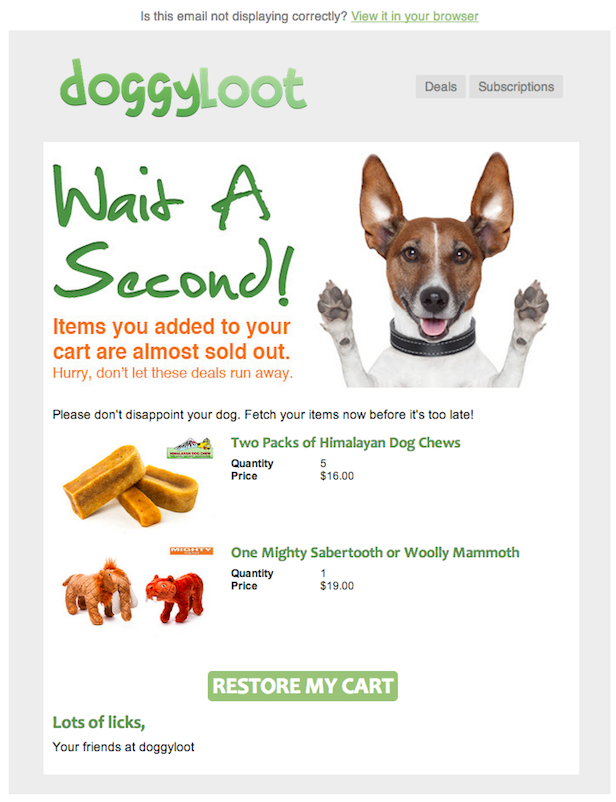 This abandoned cart email by pet suppliers, Doggyloot, is funny, but it’s also loaded with emotional triggers.
This abandoned cart email by pet suppliers, Doggyloot, is funny, but it’s also loaded with emotional triggers.
The customer isn’t just missing out on a few products – they’re disappointing their beloved animal companion. What kind of pet owner would want to do that?
Putting Ecommerce Funnel Conversion Optimization to Work
Obviously, this guide isn’t fully comprehensive. I could probably write millions of words on the subject and still not have it be complete.
Think of this instead as a starting point for optimizing your ecommerce funnel – no matter what type of store you run, who you’re selling to or how complex your marketing campaigns are.
What are some of the most impactful optimizations you’ve made to your ecommerce conversion funnel? I’d love to know in the comments below.

